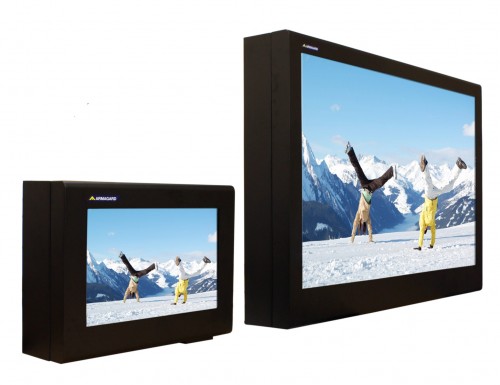Ski Resorts and the Use of Outdoor Digital Signage
Posted by: Richard Williams | Posted on: | 1 Comments
The last thing many of us would expect to see when we are up a mountain is an LCD display. However, there has been a huge surge in interest from ski resorts for LCD displays, outdoor screens and outdoor LCD enclosures – but why is outdoor digital signage becoming so popular on the slopes and how can LCD screens function in such a harsh environment?
Well ski resorts have a pressing need to provide information. Not only are important notices like ski lift opening (and closing times) important to get across to people, ski resorts are locations that are vulnerable to emergency situations.
From storms that can cause whiteouts and avalanches to other important information like slope closures due to bad snow. How do ski resorts pass on such important information?
Well traditionally it has posed problems. When the slopes are packed and an approaching storm has been spotted, clearing the slopes and warning of the dangers has always been extremely difficult.
Traditionally, ski stewards are assigned in these types of situations to physically ensure people are off the slopes but outdoor digital signage has allowed realtime warnings to be relayed – even at the top of a mountain.
Keeping the displays working
Of course, ski resorts are not the most hospitable of locations – especially for LCD displays. The climate and ambient temperature of a ski resort is obviously very cold, and with snow and other weather elements being a constant hazard, protection for any outdoor digital display is vital.
Outdoor LCD enclosures are often deployed in ski resorts because they provide the perfect internal environment for a display. Heaters are positioned inside the enclosure and are thermostatically controlled to ensure the LCD doesn’t freeze.
Sun readability is often an issue in these areas too, especially with the brightness of the snow combined with the sunlight. Anti-glare screens are deployed for this reason to ensure the displays can still be read regardless of how much glare there is.
Post shortlink:
Popular Products
LCD Enclosure
Need armor for your LCD/LED screen(s)? Outdoors or inside the versatile LCD enclosure protects against thieves, vandals & the weather. Installation idea: NFL stadiums.
Outdoor Digital Signage
Exclusive 46” outdoor screen protection. Dubbed the ‘Totem’, due to its distinct design, it repels damage threats, but attracts audiences. Installation idea: Drive-thru restaurants.
Portrait Flat Panel Enclosure
Safeguard your eye-level advertising display screen(s), indoors or outdoors. Completely customizable, add exciting features like touch screen technology. Installation idea: Restaurant frontages.
Indoor Digital Signage
Popular purchase for retail outlets! Great for ‘point of sale’ persuasion, boost your brand with static & motion advertising from a single unit! Installation idea: Mall of America.





